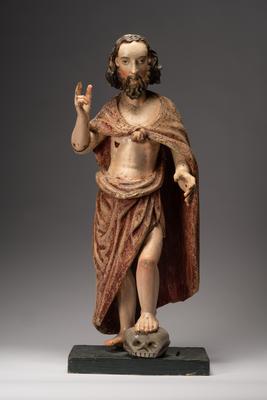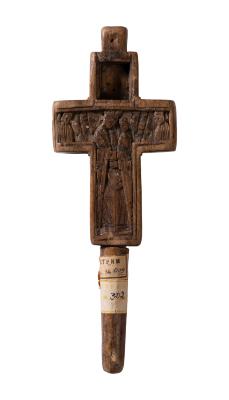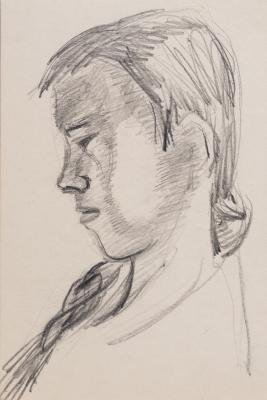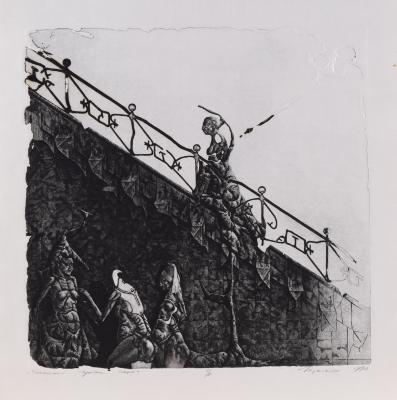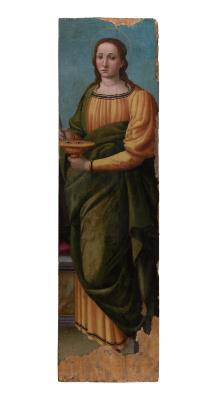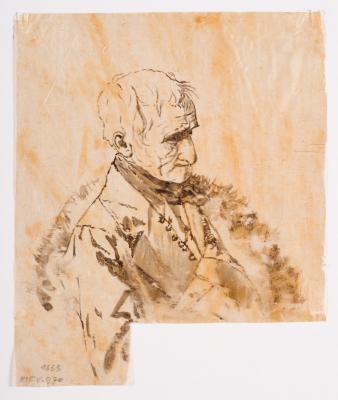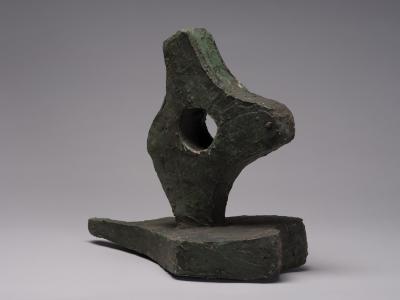Gèn (Keeping Still). Hexagram 52 (Sheet 5 from the Series "Book of Changes" (I Ching – 易經)
Alexander Aksinin
- ID
- Г-IV-4083
- Author
- Alexander Aksinin
- Name
- Gèn (Keeping Still). Hexagram 52 (Sheet 5 from the Series "Book of Changes" (I Ching – 易經)
- Date of creation
- 1984
- Technique
- etching
- Material
- imprint on paper
- Dimensions (height x width, cm)
- 10.5 x 7.9
- Type
- printmaking
- Provenance
- Courtesy of V. Onusaitis, 1987
The work is the fifth of 14 sheets of an unfinished series of hexagrams from the ancient Chinese book "I Ching". It was also known as "The Book of Changes" and stated as one of five canons of Confucianism in the 2d century BC. Alexander Aksinin had always been interested in Far Eastern philosophy. He worked on a series of hexagrams for "The Book of Changes" from 1984 to 1985 (until his death in May 1985). As a result, the artist managed to create 14 compositions, each illustrating a particular piece of 64 hexagrams. Each work was dedicated to a specific individual.
Alexander Aksinin created Hexagram 52, Gèn (Keeping Still), as a birthday present to Yuriі Hittik. The author's dedication, saying, "To Yurii L. Hittik / ♀ (symbol of Venus)", was placed in the second column of the lower text strip of the plate. Having made 10 imprints with the above dedication, the artist cut the lower part of the strip. So, the forthcoming etchings, including the one kept in Borys Voznytskyi Lviv National Art Gallery, were created using a cut plate without the final part of the text.
The composition consists of illustrative and textual sections. In the foreground, against the black sky, one can see a giant structure resembling a faceted semi-folded screen depicting fragments of the dragon's body on the faces. The black dots are connected by lines above the dragon. A seated female figure is schematically represented on the axis of the imprint at the bottom, between the facets of the structure. The woman focuses her attention on one of the black dots on the wall. This alludes to the story of Bodhidharma, the founder of Zen teachings. Legend has it that while seeking the truth, the monk spent 9 years meditating on a bare wall in a cave.
At the top, on the composition's axis, one can see a small bright circle reminiscent of the moon or a planet. It is placed on the background of the black sky. Near the edges of the structure, arranged in the perspective on the left, another barely visible figure is accentuated by the circle of the celestial body in the sky. To the right of the dominant composition, that is, the construction with the female figure, there are some additional elements. It is a bird in the foreground that resembles the Ibis bird, a symbol of Thoth, the ancient Egyptian deity of wisdom, and mountain peaks depicted in perspective and partially reflected in one facet of the screen.
Below the illustration, there is a text that contains Alexander Aksinin's interpretation of the six positions of Hexagram 52 from "I Ching" book: "concentration on the toes—favourable for eternal fortitude/ concentration in the calves—you will not save the one you follow/ stop in the hips—they move away from the lower back/ 52/ Gèn keeping still/ 4 / the fourth six—concentration in the torso/ stop in the neck—in speeches let there be perseverance/ strengthen the concentration—happiness".
It is no coincidence that the artist presented Hexagram 52 of "The Book of Changes" to his friend. Yurii Hittik was a researcher at the Institute of Economics at that time; thus, the hexagram visually depicted scientific knowledge problems. Alexander Aksinin's comprehension of the conceptual context of "I Ching" translates into developing the motives of concentration and deep immersion into the reflection.
Yurii Hittik (b. 1956), a native of Ukraine. Between 1979 and 1990, he worked as a researcher at the Lviv branch of the Institute of Economics. As a friend of Alexander Aksinin, he was honoured with four works by the artist. In 1988, Yurii Hittik published the first complete catalogue of Alexander Aksinin's printed graphics. In 2008, together with his wife, Mariia Shchur, he created a website dedicated to the artist's works. As of today, they continue to maintain the site.










